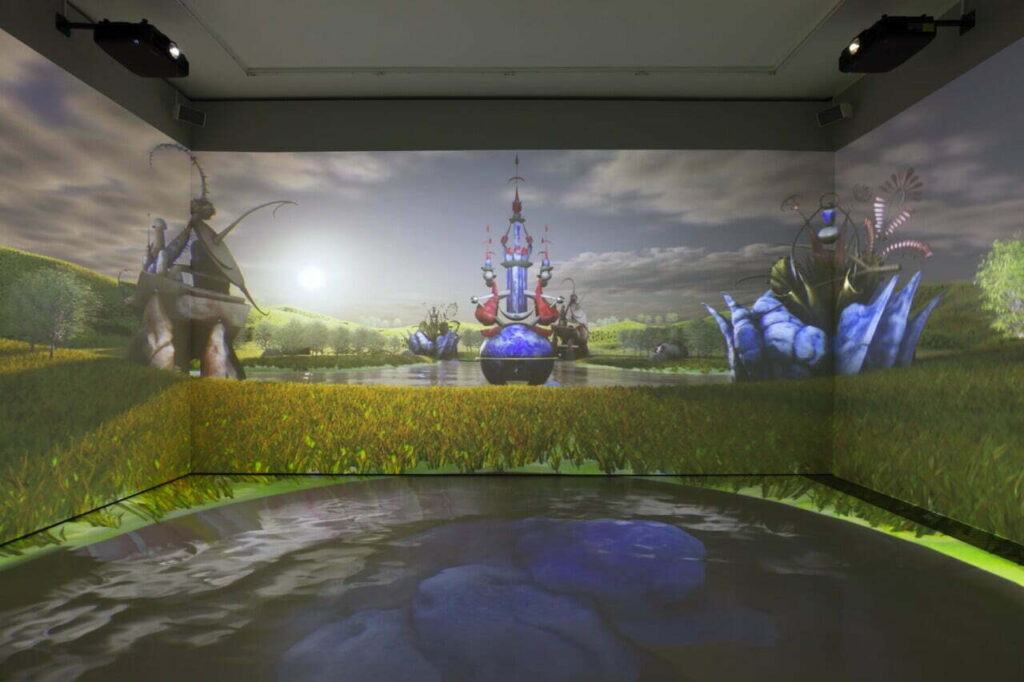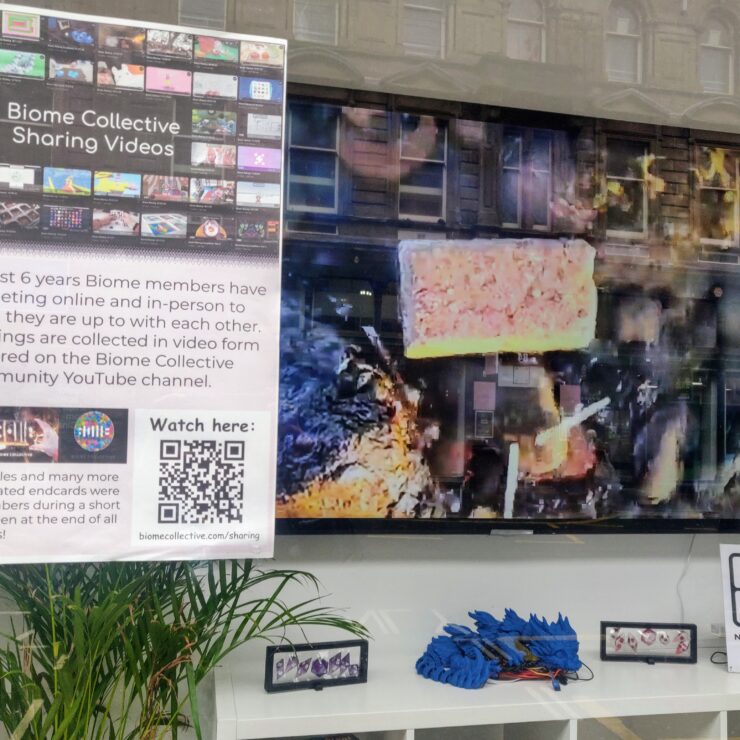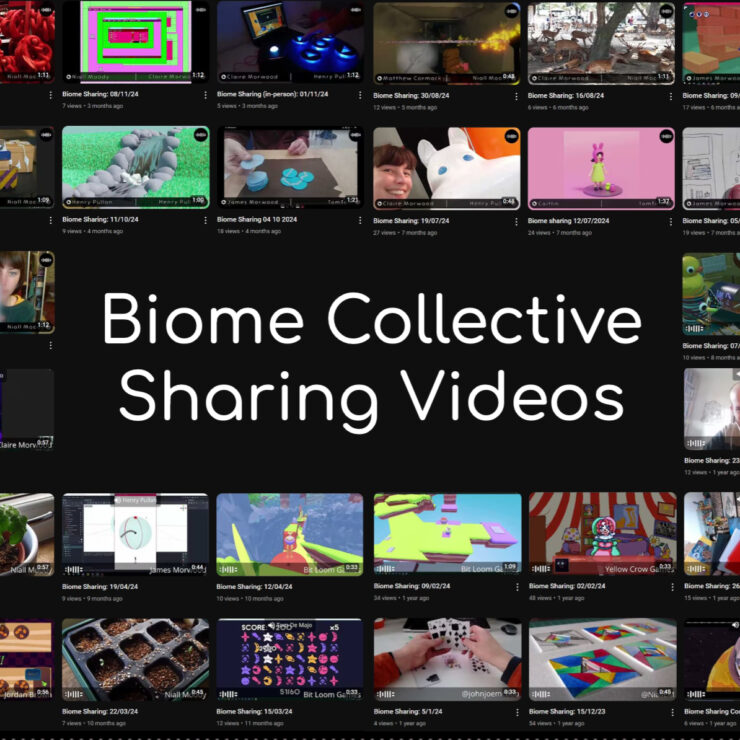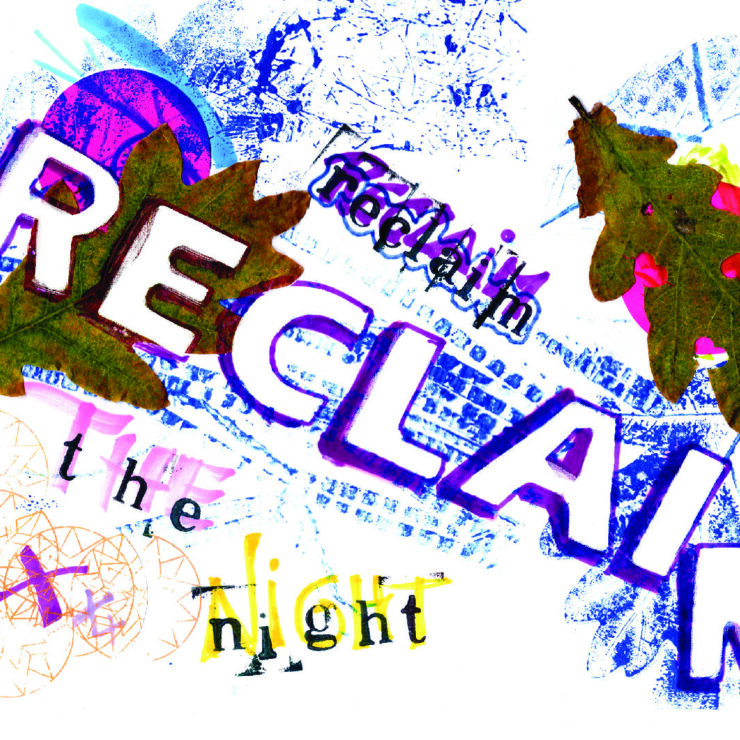Merging, blurring, entangling: an interview with Libby Heaney

Last year, artist and physicist Libby Heaney delivered a series of workshops with NEoN, which explored themes and motifs in her artistic practice. She speaks to Bilyana Palankasova about quantum and belief systems, plurality and speculation in her work.
Bilyana Palankasova: Shall we start by talking about your position as a post-disciplinary artist and what this means to you and the approach to your practice as both a scientist and an artist?
Libby Heaney: There’s been a lot written about the differences between art and science. I think there are moments of resonance and moments of dissonance.
For instance, for me, I’m still working with scientific apparatus like quantum computing and that requires me to do mathematics and then coding that on the quantum computer. Art doesn’t have any rules. If anything artists are trying to break rules, so I’m able to discuss the things that concern me from a much wider perspective in art compared to science. Now I use metaphor, visuals, materiality, affect and emotions, whereas before I worked largely with mathematics. I don’t believe in so-called objective science, yet the scientists I encountered seem to believe what they do is “the truth”. Of course, there are a lot of politics and in certain cases, colonial ways of seeing, and there are certainly hierarchies present within scientific methods. It’s not that art is safe from bias, but at least as artists we’re approaching things from our own subjective lens.

Libby Heaney, touch is response-ability, interactive animation, 2020. Image courtesy of the artist.
BP: Yes, that primacy of the scientific method and kind of ultimate truth are challenging. So, what’s the relationship between this approach and trying to develop quantum aesthetics in your visual language through your practice?
LH: Quantum physics is a physical theory that describes the microscopic world where particles like atoms, molecules, photons, exist in very different ways compared to the Newtonian world we experience through our senses. Particles can be in multiple states simultaneously until they are observed by something. The observer doesn’t need to be a human, it can be a vibration or a photon for instance. Anything that interacts with a particle in a superposition becomes entangled with it, or depending on your interpretation of quantum mechanics, the interaction collapses the superposition. What quantum theory shows us is that at its most fundamental, the universe isn’t Newtonian, it isn’t binary, it doesn’t have fixed rigid categories, and there is no ultimate truth.
I’m using a quantum method and process when I work in my practice, even when I’m working with non-quantum binary/digital technologies, like machine learning. I’m using a quantum process to deconstruct seemingly fixed categories and binaries. When I’m working with quantum computing, I can access the quantum reality indirectly. For instance, I can create quantum entanglement within a quantum computer and depending on how I choose to work with quantum entanglement, I can extract strange wave-like patterns that are unique to entangled states of matter.
I can start to see the plural ways of quantum mechanics and that enables me to create non-binary patterns or perspectives through image making, film, or 3D environments. My audiences can then tangibly experience the radical & plural potential of the quantum world.
BP: Can you expand on that relationship of working with data and working in more non-digital ways, like painting or sketching, and how that forms the aesthetic within your practice? And the methods you use to communicate your ideas?
LH: Quantum systems are very delicate. It can be very hard to create entanglement or superposition in the lab. This is why quantum computers are so difficult to build. We don’t see macroscopic objects, like mobile phones or ballpoint pens, in multiple places at once and we don’t see them or experience them, as being entangled to other things either. That’s because quantum entanglement, quantum superposition are very sensitive to their environment (to observation as I mentioned earlier). Whenever you use a quantum computer to generate entanglement and then measure it to collect your data, the plural state reverts back to binary. The matter reverts back to being describable by Newtonian physics. And this happens indeterminately. So, when I make art with quantum computing, I have to use almost like a scientific methodology, unfortunately [laughs], to show that there was superposition of entanglement there. I use techniques that scientists would use, to show that the matter was behaving in a quantum way, before the observation.
The data back from the quantum computers is just a list of numbers, which may look binary, but it has signatures of quantum entanglement within it. Two waves, like Newtonian water waves or sound waves, can merge together, interfere and create new patterns. Quantum particles behave similarly but different. Quantum waves can still merge together, interfere and create new patterns. But these patterns look different to Newtonian waves interfering. These quantum patterns can be seen in my artwork touch is response-ability from 2020 – where human bodies, Venuses from art history, or me reperforming those Venuses become plural and deconstruct, and then gradually become fully abstracted by using this quantum wave-like data to process a digital image.

Libby Heaney, Ent-, Installation view: Schering Stiftung, Berlin, 2022. Photograph: Andrea Rossetti. Image courtesy of the artist and Light Art Space.
Merging, blurring, entangling are also how I work with watercolour painting, but it’s also very different to the quantum process at the same time. Watercolour painting is macroscopic, and as far as we scientists know, not best described by quantum physics. When I’m working with watercolour painting, objects I paint are flooded with water and eventually overflow to blur together and become entangled. The forms I’m painting become boundaryless, and porous, and fluid.
Libby Heaney, Ent-, Installation view: Schering Stiftung, Berlin, 2022. Photograph: Andrea Rossett
In Ent-, my immersive work that was commissioned by Light Art Space and presented last year, quantum creatures, that I painted in watercolour, were animated using quantum data, which made them plural and boundaryless.They ebbed and flowed around the space like a weird quantum water wave. Audience members could step into that space and really feel moved in multiple different ways by these creatures.
BP: Yes, and I guess, the way in which you approach it is as a method but you’re also interrogating these themes through your work, and there’s always an element of some sort of belief, I guess? And you have talked about magic and belief systems that are in a way constructed through the work. Can you tell me more about creating that expanded world and what’s the role of sci-fi, or fantasy, or these speculative elements into creating that expanded universe of your practice?
LH: Yes, belief, fiction, sci-fi, and speculation work on multiple levels. They’re entangled. I don’t believe in dualism, so I’m not saying something’s real and something’s fake. Different threads of fact and fiction worked together in my arebyte show last year. In The Evolution of Ent-: QX, I created a fictional company, QX, to talk about real companies generating belief systems around quantum computing in order to sell early-stage quantum computers to others (even though these quantum computers are very noisy and not useful for problem solving at the moment).

Libby Heaney, Ent-: QX, Installation view: arebyte Gallery, London, 2022. Image courtesy of the artist and arebyte Gallery.
There is so much fiction in how these tools are sold and the facts around QCs and the hype are entangled. There is a lot of venture capital being pumped into quantum computing at the moment by national governments and large investment firms. The way tech companies sell quantum is very speculative because the technology is still prototypical. Art allows me to speculate, entangling fact and fiction. It allows me to think about other realities or parallel worlds beyond the capitalist, patriarchal, colonial reality. We are stuck deep in a neoliberal time, but quantum opens up portals to other directions, because quantum theory points us towards the world where there are no individuals. But it's hard to describe quantum physics in words so I think this is where visual art and emotion and affect can come in.
BP: I think it’s really interesting how that idea of speculation exists in a different context in the word of finance, which is why, it’s kind of ironic, and it has a strong subversive potential to use these methods in the context that you’re doing your work in, and specifically in the arebyte show as well. The difficulty to communicate it through language or through words, and having visual exploration of these ideas, also really works on a different plane of communication with audiences…
LH: I found a quote, Richard Feynman said “I think I could safely say that nobody understands quantum mechanics.” And John Wheeler said, “If you’re not completely confused by quantum mechanics, you do not understand it.” So, it’s like quantum thinking or quantum feeling enable us to sit with paradox and uncertainty and irreducible lack of knowledge… But thinking about representation, what art can’t do… I mean, it’s impossible to represent quantum entanglement visually because an entangled state exists in a much higher dimension compared to our three dimensions, plus time. Depending on how you look at it (when I say “you”, I mean when something measures quantum entanglement), you bring different orthogonal realities into being. If you look at a quantum entangled state one way, you’ll see something, and that destroys the possibilities that would have emerged had you looked at it in another way. I use the word “you” very lightly, because it’s not humans looking at all.
BP: Yes, and it’s this kind of plurality that is very challenging about the reality that it’s trying to show or open up. So, I guess that’s the thing that’s bringing in radical potential. And I say radical with a caveat, because I think it’s a word that’s been super overused, especially in artistic context, and I think it’s a really productive target. But I wonder, if we could speak about radical potential when thinking in these plural ways and being more sensitive to pluralities, what could that quantum computing vision or method open up for anyone experiencing the work?
LH: We’re so used to the notion of the individual in Western society. When you’re working with quantum entanglement within a quantum computer, there literally is no sense of an individual. If I create quantum entanglement between, say 5 qubits, and I try to obtain an individual out of the entangled state by measuring a qubit, I destroy the whole quantum system. It is literally impossible to get an individual out – this is why quantum cryptography is physically impossible to break. If we could bring this sense of strong entanglement alive and tangle through art and other visual means, and enable audiences to become part of that entangled system, it could really change how we experience our place in the world… it could move us beyond neoliberalism and the sense of individualism that haunts the west. I mean inviting a participant to feel quantum entangled is almost unethical, because if an audience member becomes entangled to something else, it could mean entirely dissolving their sense of self.
Say, if this was possible through art, I’m not saying it is, but if it were that I’m entangled to some entity or another person by a virtual reality or some other digital means, then myself and that other entity would exist in coherence, in multiple ways together. We would be in a layered reality, doing different things in sync at the same time through correlation. So, myself and yourself for example could both be dancing, and at the same time both be sitting, and at the same time both be sleeping and all at the same time… until infinity, in all the different possible ways of being, always doing the same thing together, connected, even if we’re really far apart. And if something interacts with us or we try to get out, everything collapses like a house of cards. It’s such a different way of thinking about reality and our place in it. It’s not just merely, oh we’re connected to everything, which is what a lot of people, including myself, sometimes say, because it’s so hard to talk about. We use entangled to say “connected” but quantum entanglement goes beyond mere connection. We use the word “entanglement” in the art world so much but often we just mean “connected”. Quantum entanglement is very different to that. And that’s why I used the word radical, because quantum states like entanglement are a totally different ontological class. Quantum states are a different object compared to any objects we’ve encountered before.
BP: I think you put that really well! I think a big challenge is also that, obviously we kind of think of ourselves as…our experience of self is often an embodied experience. So, it’s really difficult to kind of conceptualise that different plane of existence and what that means for your sense of self.
LH: Maybe we need psychedelic drugs or out of body experiences or moments of collective euphoria where our individuality is dissolved into the collective. That’s why I made a work about chanting a few years ago called The Whole Earth Chanting because through chanting you can enter the collective. And through religion you can kind of enter the collective. So, there are all of these different ways of being where our individuality dissolves into something that’s more than and I think they are very interesting avenues for me to explore.
The Whole Earth Chanting | Libby Heaney & Nabihah Iqbal | Radar
Libby Heaney bio:
Libby Heaney is an award winning artist and quantum physicist whose solo exhibitions include arebyte Gallery London and Light Art Space Berlin, 2022, which was named by Weltkunst* as one of the best exhibitions of March 2022 alongside Louise Bourgeois, Jenny Holzer n& Yves Saint Laurent.
Heaney is considered to be the first artist to use quantum computing as a functioning artist medium and her notable quantum artwork Ent- has won the Lumen Prize and the Falling Walls Art-Science Prize, 2022.
Other solo and group exhibitions & performances in 2022 include Calder and the 21st Century, Nahmad Contemporary, NYC; a month long public screening, Gwanghwamun Square, Seoul; Biomedia, ZKM, Karlsruhe; Quantum Hivemind, Serpentine Gallery, London & CASCADE, Southbank Centre, London.
*https://www.weltkunst.de/ausstellungen/2022/03/ausstellungen-maerz-2022-jenny-holzer-basel


